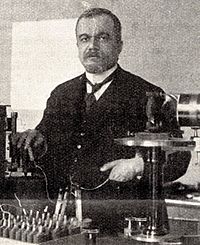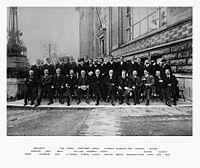Louis Georges Gouy facts for kids
Louis Georges Gouy (February 19, 1854 – January 27, 1926) was a French physicist. He is the namesake of the Gouy balance, the Gouy–Chapman electric double layer model (which is a relatively successful albeit limited model that describes the electrical double-layer which finds applications in vast areas of studies from physical chemistry to biophysics) and the Gouy phase.
Gouy was born at Vals-les-Bains, Ardèche in 1854. He became a correspondent of the Académie des sciences in 1901, and a member in 1913.
Topics investigated
His principal scientific work was related to the following subjects:
- The propagation velocity of light waves in dispersive media
- Propagation of spherical waves of small radius
- Distant diffraction (angles of dispersion reaching 150°)
- Electrostatics: Inductive capacity of dielectrics
- Surface charge
- Effect of the magnetic field on the discharge in rarefied gases
- Electrocapillarity
- Emission capacity of absorbent of the coloured flames
- Brownian motion
- Measurement of magnetic susceptibility of transition metal complexes with Gouy balance
- The gouy phase shift, a feature of Gaussian beams
See also
 In Spanish: Louis Georges Gouy para niños
In Spanish: Louis Georges Gouy para niños
- Gouy-Stodola theorem

All content from Kiddle encyclopedia articles (including the article images and facts) can be freely used under Attribution-ShareAlike license, unless stated otherwise. Cite this article:
Louis Georges Gouy Facts for Kids. Kiddle Encyclopedia.


